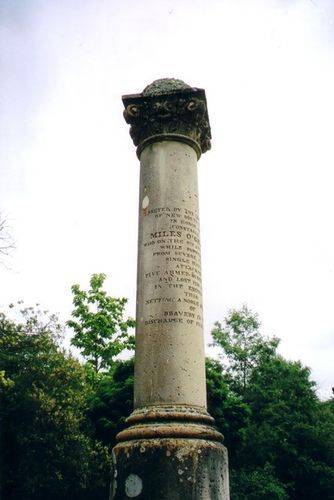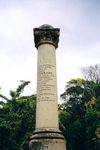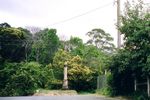
Constable Miles O`Grady Print Page 
The monument commemorates Constable Miles O`Grady, who, while suffering from severe illness, attacked four armed bushrangers and was killed in the encounter.
When Nerrigundah was raided by the Clarke gang in 1866, it was a goldmining town with a population of 1200. Before entering Nerrigundah the gang had held up travellers to and from the town, keeping their victims as prisoners. On April 9th they held up Wallis` Hotel in Nerrigundah, bailed up people passing in the street, and attempted to rob Pollock`s store. They failed in this last task because Mrs Pollock threw the keys into the street. Once notified of the disturbance, the two constables of the station, Troopers Smith and O`Grady, the latter rising from his sickbed with a fever, went to Wallis Hotel.
They fired two shots, killing one of the bushrangers. The policemen withdrew into the street where the other bushrangers, responding to the shots, had arrived. O`Grady was shot and died almost immediately. The Clarke gang then rode out of town to be pursued by a posse of twelve men. An ambush was prepared at the Eucumbene River but the only victim was a pack horse. They were eventually arrested near their favourite hideout, the Jingera Ranges.
CONSTABLE O'GRADY'S MONUMENT, The monument ordered by the Government to be erected at Nerrigundah to the memory of Constable O'Grady, is at length finished, and will be forwarded from the department of the Colonial Architect in a few days. The execution of the design was entrusted to Mr. W. Magill and his task has been accomplished in a manner that reflects credit on his skill, and on the judgment of those who employed him. The length of the monument from the base is thirteen foot six inches. The plinth is nine feet in diameter; on which rise two moulding pedestals, and the column, with a rich ornamental capital -the shamrock being intermingled with the scroll, and the whole terminating with the segment of a ball or globe. The monument will be surrounded by an iron palisade. On the column the inscription, by the Honorable James Martin, is neatly cut.
Kiama Independent, and Shoalhaven Advertiser (NSW),
14 March 1867.
Note:
An information plaque placed at the site by the council was destroyed by fire. The new plaque does not state that the bushrangers murdered Miles.
The Clarke boys came to town about 8pm - it was April, so it was dark. The town did not run to gas lights and so the only light in the street came through the door of the hotel. There were two masked men standing at the door, William Fletcher and Pat O'Connell - presumably stopping the clients from leaving. That meant Tommy and Johnny Clarke would probably be behind the bar serving drinks or robbing the till - that is my guess. They would not need to be near the door. The clients in the bar were mostly miners from 4 miles away at Deep Creek.
Miles and Constable Smith walked down the main street - (the police station was about 200 yards away and around a corner) They both fired - Miles killing Fletcher and Smith just missed Pat's head. The noise caused the clients to come out of the hotel and many of them would be armed - it was a very gun-ho society. It was not known at the time who had fired at the men in the doorway, the police did not announce themselves. Obviously people fired back. Smith retreated around a corner, Miles into a line of sight and he was shot and stumbled towards help. He lingered for 3 hours before dying. Smith stayed at the police station until summoned after about an hour, to remove Fletcher's dead body. No one made a list of the people in the hotel. O'Grady was killed with a rifle bullet - the newspaper report did not mention any rifles at the Deep Creek robberies earlier in the day, nor was the question asked at the inquest as to whether the boys had a rifle. An artist, Mr W Blyth, sketched the scene , and it was published in the Illustrated News, 16 May 1866. The good thing about the picture is it shows many shooting at the police. However it does not indicate it was very dark, and one assumes that they are opposite the hotel - not near the door of the hotel, and the police far too close - they were approaching from down the street, not across the street. A bit of artistic license happening.
They were never charged with the murder and therefore never convicted in court. When the boys - Tommy and Johnny Clarke, were finally captured the Attorney General, James Martin, asked the Inspector General, James McLerie, to collect all depositions for the various murders that had been attributed to the boys. These are held in the State Archives at Kingswood, New South Wales. On reading the depositions, it is easy to see that the boys could not be chargesd with murder - there was just not enough evidence.
Information supplied by Judy Lawson, 25 January 2021.
Location
| Address: | Gulph & Moruya Streets, Nerrigundah, 2545 |
|---|---|
| State: | NSW |
| Area: | AUS |
| GPS Coordinates: | Lat: -36.116731 Long: 149.899395 Note: GPS Coordinates are approximate. |
Details
| Monument Type: | Monument |
|---|---|
| Monument Theme: | People |
| Sub-Theme: | Crime |
| Actual Event Start Date: | 09-April-1866 |
| Actual Event End Date: | 09-April-1866 |
| Monument Manufacturer: | Mr W. Magill |
Dedication
| Approx. Monument Dedication Date: | Circa 1867 |
|---|
Erected by the Governor of New South Wales in honor of Constable Miles O`Grady who on the 9th April, 1866 while suffering from severe illness single handed attacked five armed bushrangers and lost his life in the encounter thus setting a noble example of bravery in the discharge of public duty.








 Excerpt The Clarke Bushrangers Innocent Until Proven Guilty by Judy Lawson
Excerpt The Clarke Bushrangers Innocent Until Proven Guilty by Judy Lawson
